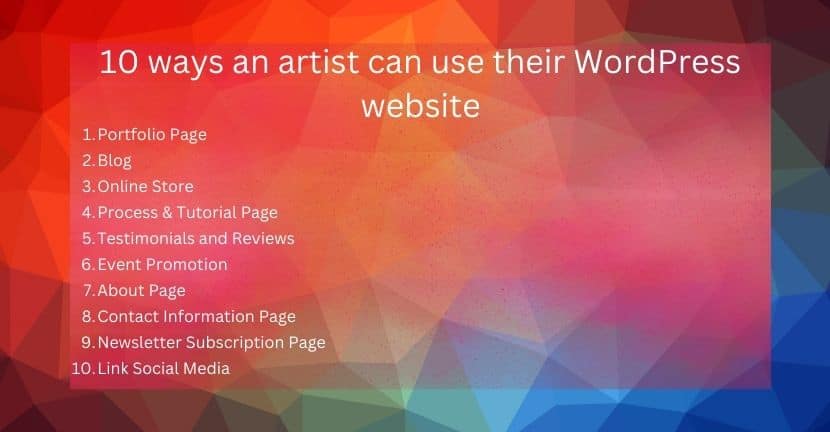In this article, we will talk about 10 ways an artist can use their WordPress website effectively and use WordPress to achieve online success.

Why WordPress?
A WordPress website is easy to create and use. It has an intuitive interface that makes it easy to create visually appealing websites. It’s the best choice for artists, as it is fast, easy and has a wide range of visually appealing themes to attract the attention of the target audience.
List of 10 ways an artist can use their WordPress website:
1. Portfolio Page
A dedicated page to showcase your artworks. Portfolio pages can be a great way to present your skills as an artist. It is also important that you invest the most time and effort in creating a portfolio page for your website because it is most definitely the first page that your audience is going to see.
A portfolio page plays a huge role in creating your first impression on your audience.
Consider your portfolio page as a digital gallery where your audience can appreciate your works. This is also an opportunity for you to show your works to potential sponsors and gallery owners/ concert organizers.
If you have a separate portfolio page, it communicates to your audience that you are serious about your art and dedicate a lot of time and effort into what you do as an artist. This builds your credibility and can help you in the long run.
2. Blog
Create a page where you can publish blog posts in which you share details of your works and behind- the-scenes secrets that go into producing your artwork. This will help you connect with the audience.
A dedicated blog page increases audience engagement and makes you more relatable. This is important as it creates a connection between you and your audience. The stronger this connection gets, the more loyal your audience will be towards you and your art.
It would be a good idea to show your audience how you overcome challenges, how you work, discuss the progress you have made on different projects and your future goals. Such content makes you seem transparent and authentic, both factors rank high in trust building.
Blog content that has strategically placed keywords can also help you with SEO and increase your website traffic.
Also, having a blog page helps in building a community among your followers and makes your website more lively.
3. Online store
If you wish to sell your artwork, be it a painting, a book or a record (literally anything!), set up an online store using plugins like WooCommerce and get ready to earn some money.
Having a page or even a website dedicated to this, will help in increasing sales. A separate page or a website for online sales will make its management much easier as well.
If you want to stay independent and need to have more control over your sales, then having an online store is a good option since you don’t have to be completely dependent on third party platforms.
You will then also have the freedom to customize the web page as you wish and create a unique shopping experience for your customers. An online store helps in building a relationship with your buyers.
4. Process and tutorial page
Create a tutorial page to engage with the audience and create an art loving community. Process and tutorial pages are great for making your audience aware of your work style which makes them want to appreciate it.
You can also monetize advanced lessons and tutorials.
5. Testimonials and reviews
If you have enough verifiable testimonials and reviews then you can create a separate page for it. This will help you present these reviews in a much more comprehensive manner.
Make sure that you present both positive and negative testimonials. Balanced presentation of testimonials and reviews are perceived as more authentic and trustworthy.
Potential customers always look for testimonials and reviews, so having a separate page for it is never a bad idea. This would only contribute to an increased chance of conversion.
6. Event promotion
An event promotion page will be used to inform your audience the details regarding any of your upcoming events. This is a great option for those artists who participate in events like an exhibition or those who conduct or take part in shows or concerts.
This page will be used to communicate ticket details, locations, timings etc. Having a page that is dedicated to events will create a centralized hub for all information related to events, making it easier for your audience to search for such information.
It also adds an extra star to your professionalism and makes you look well organized. It displays that you are dedicated to serve your audience with all information and keep them updated.
An events promotion page can be a visually diverse page, with pictures from all the events and can be a page for elements like forms, buttons and comment sections.
7. About page
Let your audience get to know you better through a dedicated page that displays details related to you, your work and your journey in the world of art. This page provides a great opportunity for you to allow your audience a peek into your life as an artist.
This is another page which can be used to create trust and familiarity. Every artist’s journey is unique. Unique stories are great for capturing your audience. So make the most of it with an “About” page.
It also gives a “human” touch to your website. When you talk about your personal experiences and your artistic journey, you close a major gap between you and your audience.
Having an “About” page in your website can communicate to your audience that you have a considerable level of knowledge and expertise in your field. This increases their trust in your work.
8. Contact information page
A contact information page can be used to share the contact details such as your business/ office mobile number, your official email id and social media handles. Creating a separate page to provide your contact details will be helpful for your audience to navigate and extract the required information.
You can provide information about the different ways through which your audience can contact you. If you have an offline address where they can come to meet you, you can provide a detailed map too.
A contact information page would be really useful for your audience. They can ask you doubts and make your connection stronger.
9. Use the website for newsletter signup
You can create a page or a dedicated section in an existing page where you can put up a signup form. This form will be used to sign up for your newsletters. The newsletters are meant to keep your audience engaged and stay up to date with your progress as an artist.
Newsletters are an amazing marketing tool. Use it to your advantage and increase the engagement of your audience with your content.
Having a newsletter will keep your audience in the loop. It is a direct channel of communication between you and your audience. You can directly inform your audience and keep them up to date.
This page is also a great place to collect your audiences’ data that can then be used for improving marketing methods and use it for audience segmentation.
10. Link social media accounts
There’s a fairly good chance that your social media accounts have more engaging content than your website. You may also prefer to regularly update your social media account content rather than your website content. So it’ll be a good idea if you link social media accounts to the website to expand your online presence and make it easier for the audience to connect with you.
You can use social media to promote your website, and you can use your website to promote your social media presence! You will be able to promote both and increase audience engagement with your content, potentially leading to a growth in sales.
Using social media to build a community among your followers is more effective than using your website because the former method is more intimate. People use social media more regularly than they use a website. So linking your social media accounts with your website is a great way to establish a connection with your audience.
Having a WordPress website allows you to provide a complete view of your work and journey as an artist. Try out some of these methods to make use of your WordPress website and grow a community of loyal audiences.
